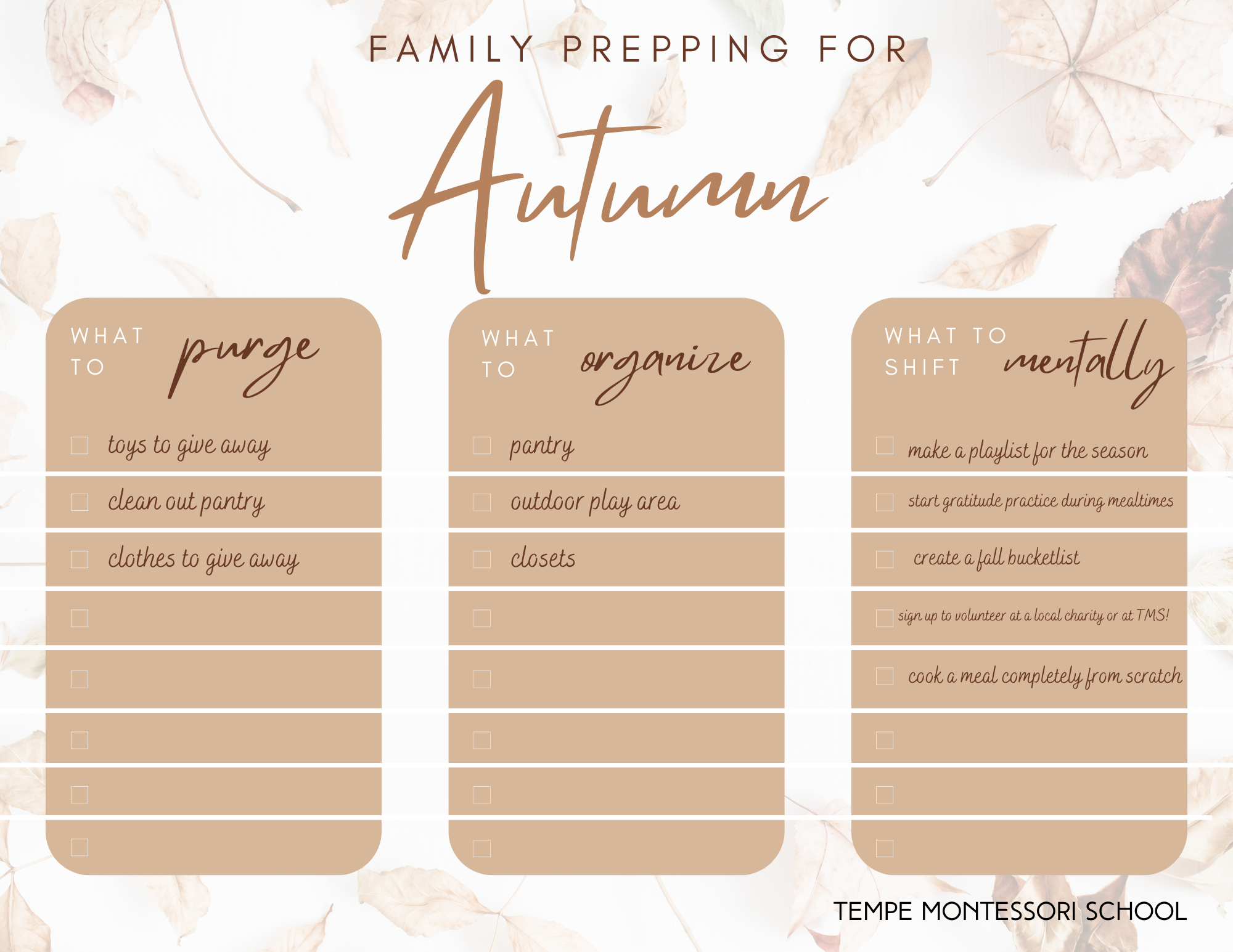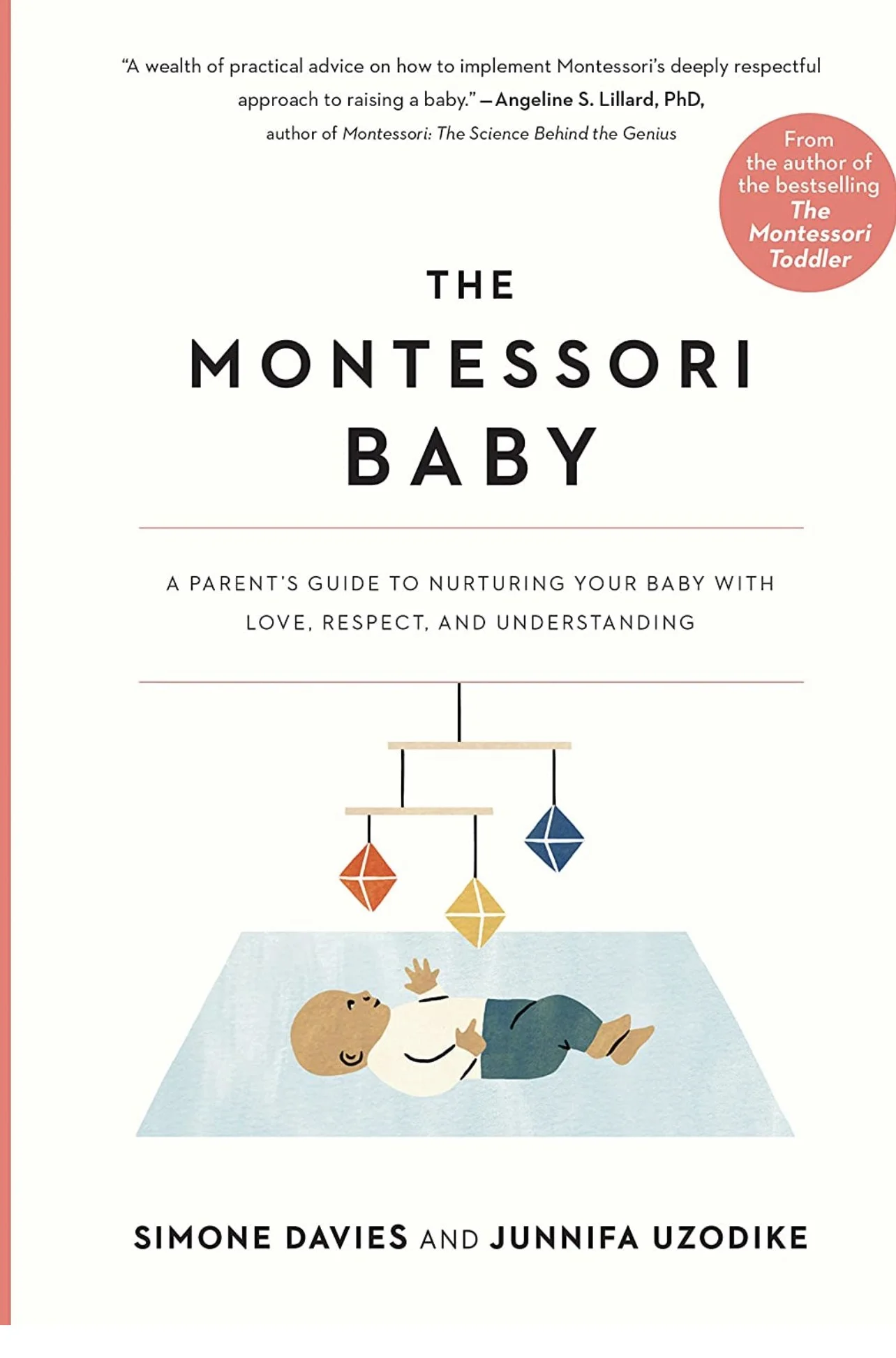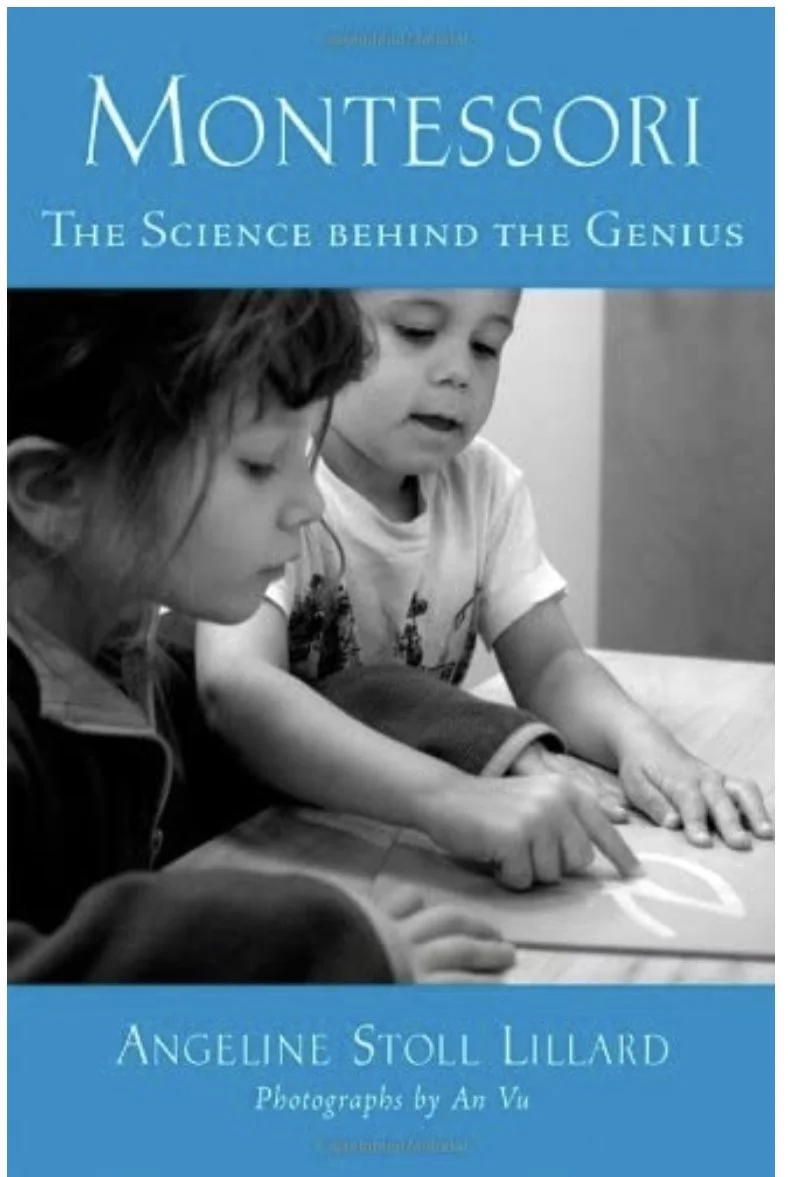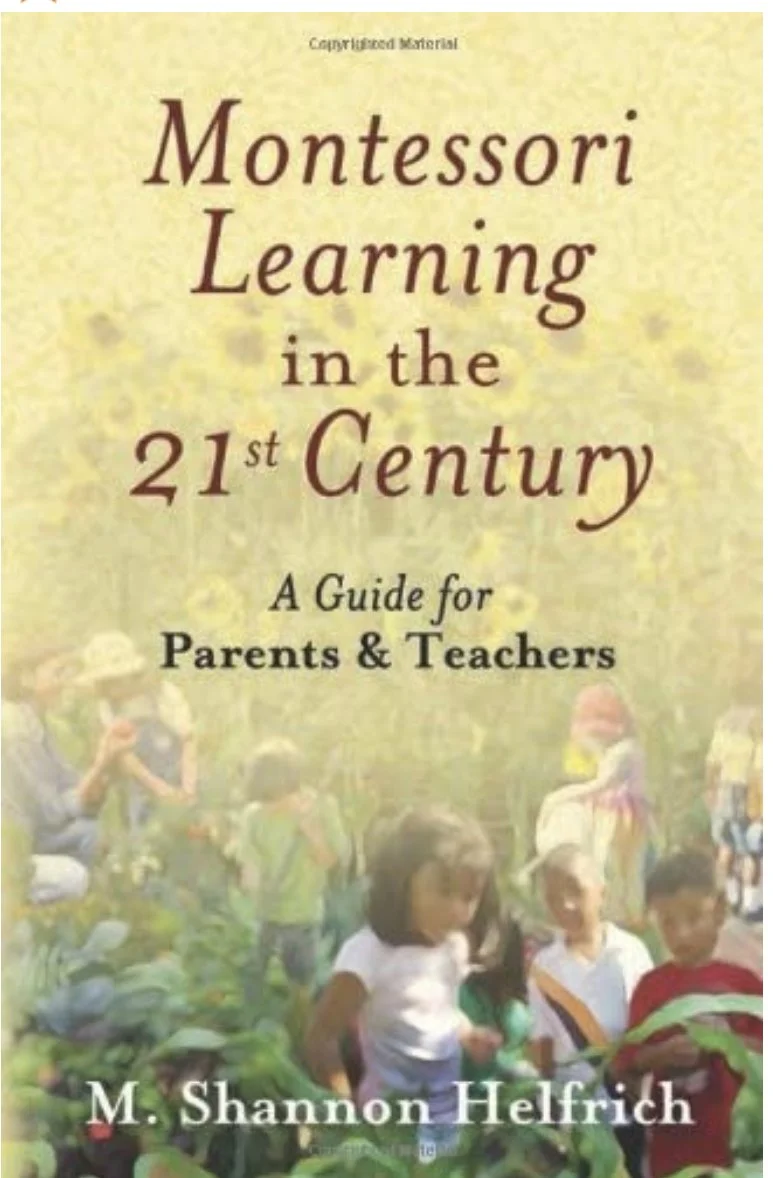Breast Cancer Awareness
Wear Pink this Wednesday
During Breast Cancer Awareness Month in October and throughout the year—people wear pink ribbons to honor survivors, remember those lost to the disease, and to support the progress we are making together to defeat breast cancer.
We invite our students and families to WEAR PINK to school on Wednesday, October 19th.
Fall Break Activities
Autumn activities to try at home.
Let’s set ourselves, our families, and our children up to enjoy all the goodness autumn brings. After the long summer months, we often need to intentionally hit the reset button - for our minds, our hearts, and our homes. Fall break provides the perfect opportunity to properly welcome the new season before it creeps in quietly and quickly, allowing the year to end in a blur. Autumn is time for purging and big exhales; a type of Fall “reset”, if you will. We can begin with our minds then our physical spaces. Let’s relish in the reward of ridding these places of unhealthy or unnecessary clutter and make room for something more worthy to take place. Involve your kids in decluttering or changing out spaces in their rooms or common rooms in the home. Let them take a look at what they can shed in order to make room for any growth this season may hold for them. Once we all breathe a little lighter, we welcome fresh perspective in this new season. Involve your children in making lists of things they want to feel or see and understand with renewed clarity.
“Autumn seemed to arrive suddenly that year. The morning of the first September was crisp and golden as an apple.”
As fall approaches, instead of bracing ourselves for the chaos, let’s prepare to fully embrace its goodness. Because even more than the rushed mornings and hectic schedules that this season promises, what it offers us in even greater measure is growth, gratitude and wonder. Here’s to celebrating this new season!
(TIP: When creating activities and spaces for children, inside or outside the home, consider all five senses; the things we are smelling, hearing, touching, tasting, and seeing.)
International Peace Day
Peace Day is September 21st.
On Wednesday, September 21st, our community will be celebrating the International Day of Peace, also known as Peace Day! Peace Education is a major aspect of Montessori education, the opportunity to honor and reflect upon the importance of peace is one we feel lucky to share. From the earliest ages, our students learn to think globally about humanity and our place in the entire system of our planet. From lessons in Grace and Courtesy to Peace Tables and cultural studies, Peace essentially becomes a habit that our Montessori students acquire. Peaceful communication is our lexicon. Montessori children are constantly practicing how to view and treat others with respect. Peace is an amazing concept, a useful tool, and through Montessori education, an attainable goal; one worth celebrating and giving serious consideration to.
Peace Day Happenings at TMS:
Our internal community (students and staff) will join together on the field to form a giant human peace sign and sing Light a Candle for Peace and Peace Like a River. We invite our families to practice singing these songs with your children at home.
We ask that all students and staff wear a WHITE T-SHIRT on Peace Day!
Stop by our photo booths outside during arrival or dismissal to capture family photos and be sure to tag @tempemontessori on social media.
Elementary students will decorate the exterior campus with peacemaker research and art projects. Be sure to check them out!
“Let’s unite, teachers and pupils alike. We all have to commit unanimously to a common and noble goal: to serve humanity.”
We’re on the map!
“On September 21st, Montessori schools all over the world will sing for peace. The song travels from the eastern shores of New Zealand to the western shores of Hawaii. From country to country, city to city, children take a few moments on this special Internation Day of Peace to remember the world needs peace more than ever! Join us and help spread the message to light a candle for peace, for love, for life!”
Montessori at Home
Montessori gift ideas for your kiddos.
We are approaching the beautiful yet busy Autumn season. This time of year is filled with the magic and sparkle that change brings, when the leaves begin to fade and fall, reminding us how lovely it can be to just let things go… to exhale. It is also a time of wonder and exploration for children as they feel those first crisp fall morning breezes. There is something so special about the memories this season brings to us as adults, and it is important for us to remember how we developed these touchstones. Grandma’s cranberry sauce simmering on the stove, crisp scents of cinnamon and apple baking in the oven, fond visions of colorful sunsets and cracking wood as while we gather around our first fires of the season and the days shorten a tad. How about that sticky feeling of pulling fibrous strands and slippery seeds out of pumpkins and gourds? It is a time to gather and make memories. We feel coziness in our hearts as we spend quality time with family, neighbors, and friends. Autumn also brings harvest and is a time of abundance. Autumn reminds us of the power of gratitude and giving. It is a time to share, a time to reflect, and a time to help. There is much to anticipate especially with the holiday season trailing closely behind.
To help you plan for the months ahead, our Lead Guides have comprised lists of their favorite things to encourage Montessori at Home activities for each age group. As you begin to consider holiday gifts for your kiddos, we hope this will serve as a reference. Tip: Share this with your loved ones who may wonder what to gift your child(ren) with!
Tempe Montessori School partnered with For Small Hands (Montessori Services) as a school credit program. Every order above $25 earns credit we can use for classroom supplies and materials. It is a win-win! Simply enter our School Customer Code: 120270 at checkout or in the comment box!
Dr. Montessori’s Birthday
Honoring Dr. Montessori’s Legacy with our favorite books for parent education.
On August 31, 1870, Maria Montessori was born in Chiaravalle, Italy. Today, and every day, we acknowledge and honor her role in advancing education, her deep research, conveyance, and advocacy of children’s rights, and her role in promoting peace and social justice. Her mission continues to advance across the globe through thousands of students working in Montessori classrooms. She believed that through the child, we can create a better world. The common thread Montessorians continue to share is the absolute, unassailable belief in the goodness of every child born.
Happy Birthday, Dr. Maria Montessori!
We invite our families to consider deepening their understanding of the vastness of Montessori education by providing recommended reading, blogs, and podcasts:
Director Spotlight: Lauren L. Bolar
What does excellent leadership look like? Humility, empathy, the ability to think strategically?
Q: First of all, congratulations! A little bird told us that you recently assumed the Executive Director position at TMS. After 44 years of successful operation, how does it feel to take over your family's legacy?
“It is an honor to be in this position. I look around Tempe Montessori and see so many aspects of my childhood here. My handprints are in the cement by the banana trees, we dug and built the pond by hand, (and swam in it too), I lost my first tooth sitting at the long table on the Primary playground, learned all the countries of Africa in Mrs. Nazli's (now Mrs. Smita's classroom), I took the long trek up the hill that now seems so small like all the children do today. My grandmother opened TMS in 1978, she worked in public education with children of all backgrounds and wanted more for them. My mother helped my grandmother run the school until her passing in 2007. Since then, my goal has simply been to continue what was started so long ago.
To continue building a learning environment for the children to truly grow in all aspects of their life. The real legacy lies in the stories of Irma Letson as they are hers to tell. When she is approached to speak, write in magazines, etc., she simply says no, as she is just one woman with a small school and a hope for a better world for the children. As we continue forward, it is important to maintain this humbleness and dedication to the practices and principles she started with 44 years ago. I only hope and strive to maintain their vision with the same level of integrity, ethics, care, wisdom and love.”
Q: Two words, one powerful question: Why Lead?
“In the words of my niece Charlotte, "It's the right thing to do." I think to lead isn't always a chosen path but one a person naturally finds themselves in and to be a leader looks different on different people. It is important in a community of people, they have a person to look to for a grounding source and sense of direction with a strong base of integrity and ethics. I strive to be an honorable leader for those around me.”
Q: Many of your Head Faculty members have taught at Tempe Montessori School for over ten years and some tenures are even scathing three decades! What is your secret for retaining such talented Montessorians?
“The secret is in the sauce. Over the years, Irma, my mother Therese, Jessica and now myself, believe in Montessori and believe in our staff. I can name at least five accolades for each and every one of them. They are truly a special group of women who believe in the child. Our teachers believe in the child and this belief allows them to continue their work in our classrooms.”
Q: In your personal opinion, what is the significance of maintaining a true Montessori atmosphere for children throughout all program levels?
“To me, a true Montessori atmosphere is one that allows for intrinsic learning. A Montessori classroom is going to have a high level curriculum, beautiful materials, and a carefully curated space. However, a room that is too controlled by the adult or has no limits and boundaries, doesn't allow for the child to take in impressions on their own will and volition. It doesn't allow for intrinsic learning. An intrinsic learner is going to think outside the box, stand up for what they believe in, question everything, to have a full understanding of themselves, society and the world around them. I always say, it's not just the academics, its the quality and characteristics a person has develops from being in a Montessori classroom setting.”
Q: What is the most difficult aspect of your work? What is the most rewarding?
“The challenging part is wanting to be everywhere at once, to sit in the classrooms, answer the phones and the emails, get the paperwork done and touch base with each person every day. The most rewarding piece is being a witness to "that moment". That moment is when the hand and the brain work together and you can see the child's understanding of their work in their eyes, their "Ah ha!" moments. As well as the little moments, when the children provide comfort to each other, check on each other or stand up for themselves. These moments of empathy, compassion and self respect are beautiful. *insert chefs kiss*”
Q: Montessori practitioners refer to this educational method as an "aid to life". What does this mean to you?
“I started the Nido program 12 years ago. I get asked "What do you teach babies, what do you do all day?" My simple response is "I do not teach anything as the work is their own. I provide a space for the children to naturally develop their bodies, minds and souls. The room is purposely set up for them to entice movement, discovery and social skills. I let the child show me what they are capable of doing and want to try and I provide the right tools for them to do so." This is what aid to life means. I can not do for the child, they can only do for themselves, so I must aid in their development and not be an obstacle in it.”
Q: In today's society, major emphases are constantly analyzed regarding the demands and skillsets our current generation of learners must possess to ensure they are key contributors to the careers of tomorrow. Where do you see the future of education heading and what are some attributes you see Tempe Montessori School's alumni demonstrating?
“I think it is very easy to look around the world and see all the ugly things currently happening. I have 17 nieces and nephews all in different school systems and each system focuses on something different. Yet, some of them are more bombarded by these ugly things in their school systems than others. When I discuss what they are learning in school, I am sometimes shocked to hear the content or the context of their days, (this is how I know I am an adult :)) A Montessori child has many opportunities during the day to see more of the beautiful and has the time and capability to make an impact in the world as they grow into adult hood and emerge into the community. Our TMS alumni are doing great things in the world. We could name a few who are notable doctors, nurses, fire fighters, financial planners, teachers, lawyers, scientists and even an astronaut! Going back to my earlier comments, it's the qualities and characteristics a Montessori child develops that allows them to see the world from a different lens. They often are found in careers of leadership or service. I find they naturally seek and create ways to contribute to society in a positive way.”
Q: Some say personal mantras should not be spoken aloud. However, for the sake of visionary and strategic thinking, please share your interpretation of Tempe Montessori's mission in a few short words:
“Our mission has remained the same from the beginning: To provide a quality AMI Montessori education for the children, and to help parents achieve their highest goals in the education of their children, by following the teachings of Dr. Maria Montessori in an effective and sensitive manner.”
Q: Lastly, to delineate the magical core of what makes this school feel SO BEYOND, "just a school", tell us a little bit about TMS' community:
“TMS has a wonderful community. We are a group of women who believe in the children and each other. We work together to create uplifting, beautiful environments to meet the needs of the children. We continue to learn and grow from what the children show us in their every day development.”
Lauren L. Bolar, Executive Director
“The future requires us to tap into a deeper level of our humanity; who we really are and want to be as a society. This is at the core of leadership work today.”
-Otto Sharmer
Grace & Courtesy
These lessons are the bedrock of our programs.
“The things he sees are not just remembered; they form a part of his soul.”
0-3 years old
Toddlers are very empathetic. They become concerned when hearing a baby cry and are quick to offer help and sympathy if someone is hurt or seems sad. They have a natural propensity to serve others. They can identify these emotions within themselves and are able to show an awareness of and compassion for others through this empathy. Early lessons of grace and courtesy develop positive interpersonal skills that will serve children throughout their lives. Demonstrations of Practical Life activities involving Grace and Courtesy, as well as modeling this behavior, are designed to nurture a child’s natural qualities of Grace and Courtesy, and his inherent desire to contribute to the peaceful order of his environment. Using clear language and modeling, Montessori teachers present these lessons to provide structure so the child can know her place, not only in the Montessori environment, but in the world at large.
3- 6 years old
Children between the ages of 3-6 are fascinated by social relations. Owing to the nature of their absorbent minds, they are absorbing the language and movements of the people around them. This includes the language and movements of the social interactions between people. They are adapting to their own cultures; they are taking in the customs and practices and beliefs of the population they live in. We engage the children in little vignettes or role play scenarios that we perform and that they can replicate, and they can practice them with each other.
The technique that we use for introducing social relations in a Montessori setting is called the lessons in grace and courtesy. Grace refers to the individual and our way of moving and using energy efficiently. It refers to how we carry ourselves as an individual. Grace is the harmony between our mind and our body. We support the child’s developing physical grace as well as his social grace.
Courtesy refers to our way of interacting and the efficient use of energy in our relationship to others. Courtesy is the harmony between oneself and others. Grace is a part of courtesy. Sometimes being courteous involves a direct interaction with another person. And sometimes it reflects a behavior, it takes the other persons wellbeing into consideration without a direct interaction. Courtesy includes showing interest and showing respect for oneself and the other person.
To better understand the relationship between grace and courtesy, think about this example: an individual can carefully carry a chair through an empty room and could be considered graceful. To carry the chair carefully through a crowded room full of other people and furnishings and to be able to do that without disturbing others, that would be considered courteous. When we are trying to be courteous it adds a little extra stimulus for us to be graceful.
6-12 Years old
This work begins in the casa where it is introduced to empower first plane children to adapt to their society and to increase their level of independence. In the elementary, this process continues as new levels of independence are reached, (or as they are being acquired). A new set of Grace and Courtesy conventions are required. Not all events/ situations demand Grace and Courtesy presentations. Some may just require a short conversation or counseling session with a child or children. Others may be left alone for the community to modify. When the teachers in the room feels it is appropriate to have a Grace and Courtesy lesson, when they are presented, they differ. The children see both the appropriate and inappropriate way to respond. This also gives the children an opportunity for expression, drama, and to see a reflection of behavior when it is outside of themselves.
What is appropriate for a grace and courtesy lesson?
Anything that will help a child to be a master of his own actions in his daily life would be appropriate.
Depending on the age of the child, would determine the lessons for the classroom. The guide will observe the classroom and their interactions with each other. When she sees there is somewhat of a conflict in either grace or courtesy, she will create an exercise to provide the tools (language, body movement and reaction) for the children to practice.
Examples in each age group:
Nido:
How to sit at a table.
How to drink from a glass.
How to dress / undress.
How to greet someone.
How to use our hands.
How to use materials.
How to wait your turn.
How to use silverware/ drink from a glass.
Toddler:
How to ask for help.
How to wait for playground equipment. (swings, bikes, jump ropes)
How to carry a tray.
How to sit in a chair.
How to use silverware/ drink from a glass.
How to dress/ undress.
How to use appropriate language to express wants/needs.
How to roll/ unroll a rug.
How to move about an environment in a careful/ respectful manner.
Primary:
How to walk around another person’s work.
How to ask to be left alone.
What to do when someone calls you a baby.
How to ask for help.
What to do when something falls off a table.
How to ask another person to move.
Elementary:
Grace and Courtesy as a winner/loser.
Grace and Courtesy at a Public Performance.
Grace and Courtesy When Working as Part of a Team.
Grace and Courtesy lessons are not ones that happen once a year. They are done all day, every day and in repetition. The child needs to see / hear something 1000 times to commit it to memory. We ALL must practice Grace and Courtesy even into adult hood. As we interact and react with our society, we need to investigate ourselves and check our reactions and interactions with how we are functioning.
Grace and Courtesy lessons can be done at home.
Just as a teacher does in the classroom, a parent does at home. Take some time to observe your family dynamic and home environment. What desired behaviors would you like to see in your child/ family at home? For the older children (5-12), involve them in the conversation, ask your children what they think can be improved. This can happen as a family meeting, during dinner etc. In the Elementary classroom weekly community meetings are held. If a child would like to bring something to the classrooms attention or suggest a change, they write it on the agenda and are able to address the class with these ideas, thoughts, suggestions and feelings.
How it is done.
It takes a practiced effort from the adult. We must always model the behavior, the language, and the desired outcome. If we expect children to put their belongings away, we must put ours away. If we want the children to respond with kindness, we must respond with kindness. We are the tools for the children, and they will use us as their resources for how to interact with society and practice self-respect.
We must remember that grace and courtesy is not just verbiage working through a conflict but is also a demonstration on how to complete a task. We must model behavior to the children, telling them is not effective; certain tasks are second nature to us and not them. Possible opportunities for a Grace and Courtesy presentation that may emerge from the Guide’s observation of children. Grace and courtesy is how we ask for things and thank each other. Grace and Courtesy is also a process of adaptation. We continue to work on establishing an attitude to promote peace in ourselves and in the world. As we continue looking at ourselves, it is of great importance. To transform yourself and to be aware of how we do things such as, being mindful of our gentleness. being attentive in the way we live with respect to the people in the environment you are in, Collaboration with all relationships, Speak with the language of kindness and love. Be understandable to disturbing behavior.
These lessons include, but are not limited to:
Attitude of respect of acknowledgment of the human beings, will benefit the contribution to the atmosphere of peace. Such as: personal hygiene, wiping noses, covering coughs, sneezes, yawns, body movement, language etc.
Insist that grace and courtesy is a human responsibility.
greeting someone
introducing oneself
shaking hands
receiving visitors
apologizing/excusing oneself
watching and observing others
waiting
taking turns
interrupting/asking for help
using a quiet voice
speaking in a polite tone
saying please and thank you
blowing one’s nose
coughing and sneezing
washing one’s hands
inviting and refusing a partner or playmate
respecting others and their space
walking around people and objects
sitting on and putting away a chair
walking in line
offering food
caring for works, books, and the environment
rolling a rug
carrying work or objects
being silent
being kind
making friends
taking out all trash on trash day
dishes
Sanitize all technology (tv remotes, phone, iPad, laptop, x box, PlayStation)
sweep floors
Clean inside of car (from a busy week)
Here are more options for Grace and courtesy…….
Mealtime (how to eat over our plate and how to scoot your chair close to the table)
how to have an inside voice
how to walk inside the house
how to load or unload the dishwasher
how to make your bed
how to welcome/greet somebody into the house
how to see if the bathroom is available to use
how to serve one’s own snack
how to take care of family animal
Interfering with each other’s work.
Leaving someone out.
Using unkind words.
Failing to take turns.
Having difficulty with conversation conventions
With another individual
Within a group
Sitting in a chair inappropriately
Handling materials incorrectly
Leaving work out/in inconvenient places for the group
Moving inappropriately in the classroom
Using their voices with inappropriate volume
Having difficulty lining up
Unable to join a group successfully
Unable to receive a presentation
Using poor hygiene – Hand washing, sneezes/coughs/nose blowing
Exiting/entering the classroom/building
Unable to take “snack” appropriately
Behaving inappropriately with “special/s”
Not understanding conventions inside/outside classroom.





































